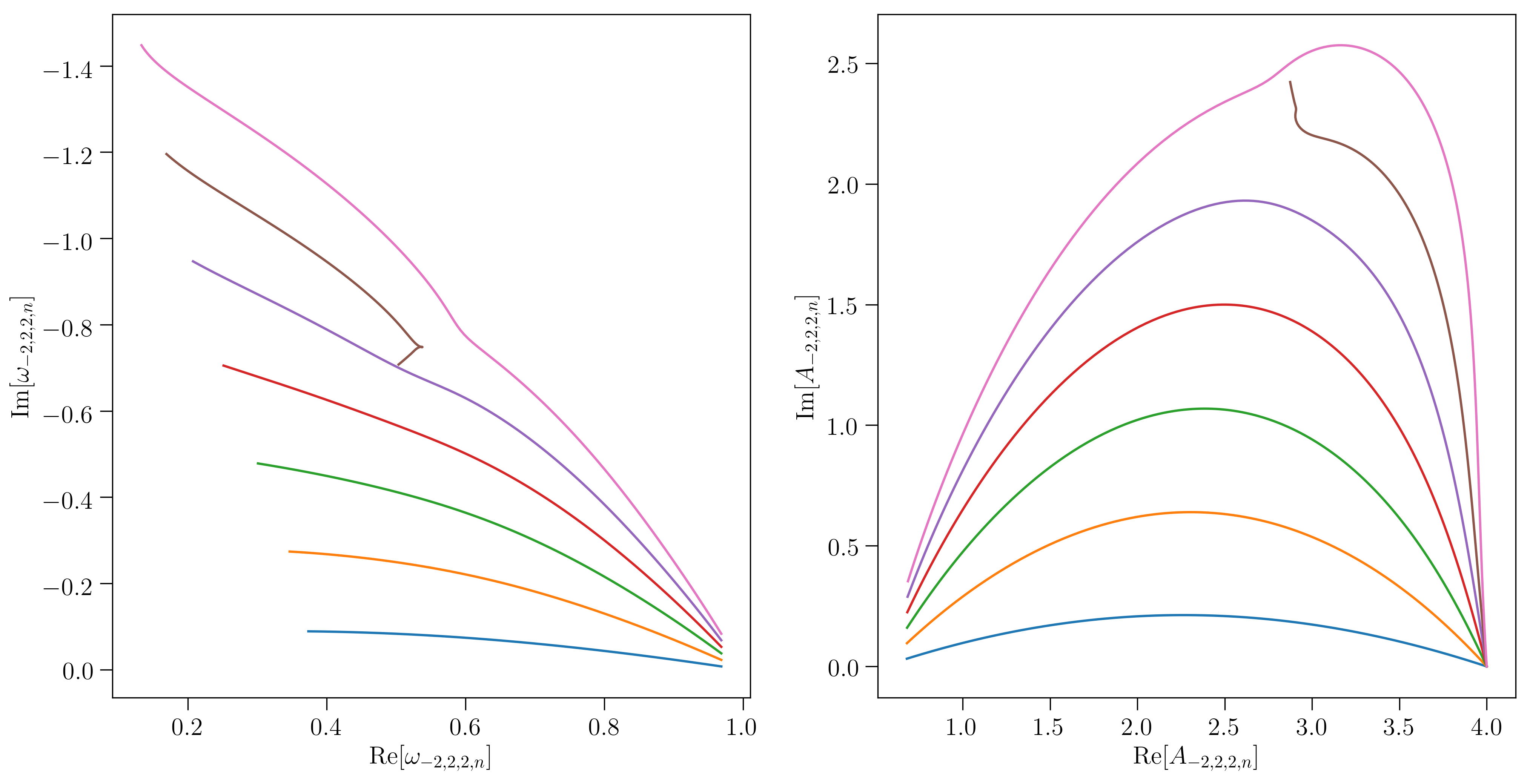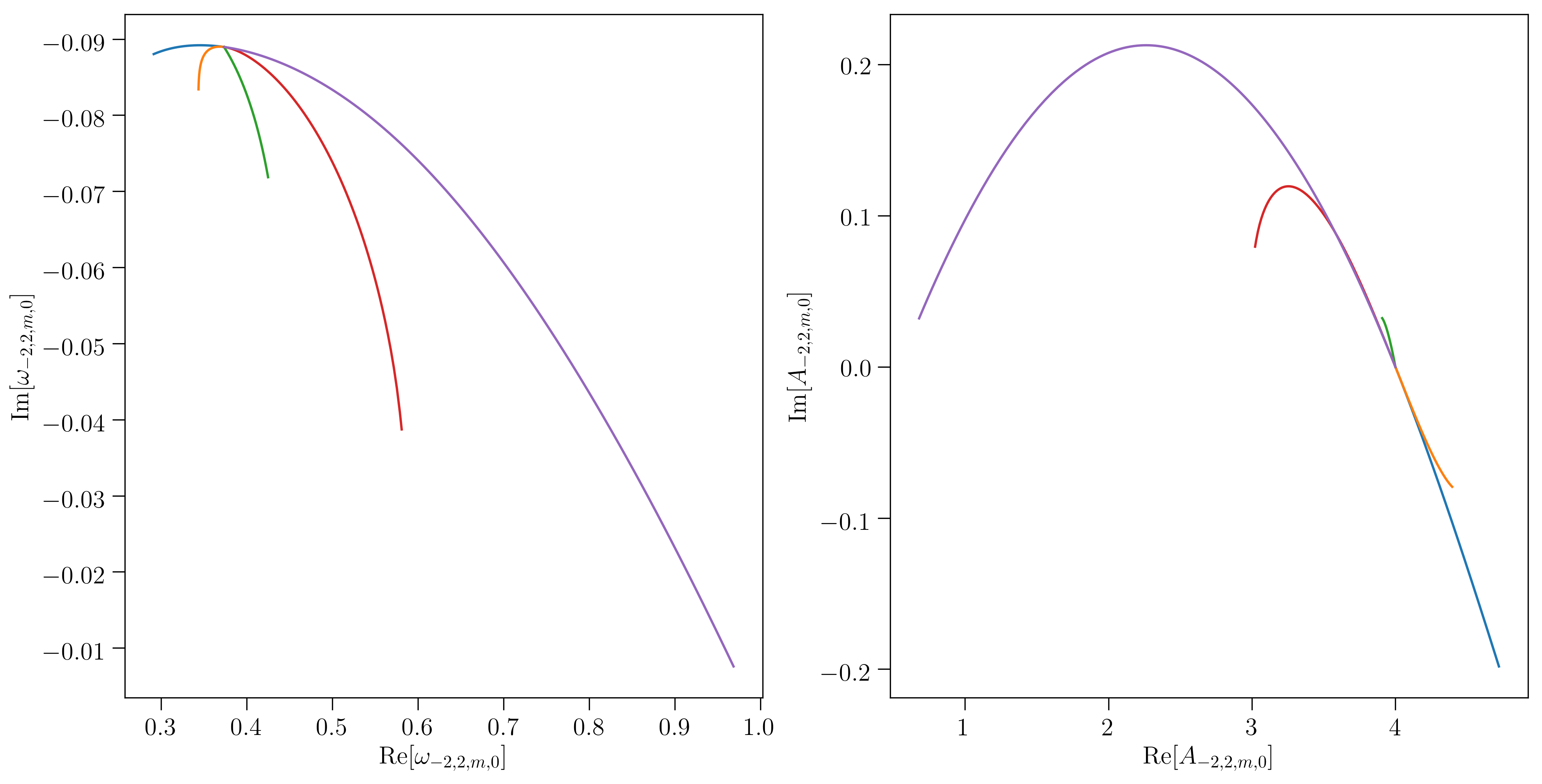qnm is an open-source Python package for computing the Kerr
quasinormal mode frequencies, angular separation constants, and
spherical-spheroidal mixing coefficients. The qnm package includes a
Leaver solver with the Cook-Zalutskiy spectral
approach to the angular sector, and
a caching mechanism to avoid repeating calculations.
With this python package, you can compute the QNMs labeled by different (s,l,m,n), at a desired dimensionless spin parameter 0≤a<1. The angular sector is treated as a spectral decomposition of spin-weighted spheroidal harmonics into spin-weighted spherical harmonics. Therefore you get the spherical-spheroidal decomposition coefficients for free when solving for ω and A (see below for details).
We have precomputed a large cache of low-lying modes (s=-2 and s=-1, all l<8, all n<7). These can be automatically installed with a single function call, and interpolated for good initial guesses for root-finding at some value of a.
qnm is available on PyPI:
pip install qnmqnm is available on conda-forge:
conda install -c conda-forge qnmgit clone https://github.com/duetosymmetry/qnm.git
cd qnm
python setup.py installIf you do not have root permissions, replace the last step with
python setup.py install --user. Instead of using setup.py
manually, you can also replace the last step with pip install . or
pip install --user ..
All of these can be installed through pip or conda.
- numpy
- scipy
- numba
- tqdm (just for
qnm.download_data()progress) - pathlib2 (backport of
pathlibto pre-3.4 python)
Automatically-generated API documentation is available on Read the Docs: qnm.
For a didactic introduction, you can watch my talk at the Spring 2020 BHPToolkit Workshop (starting around 4:11:02 in the stream. You can also follow along with the qnm presentation notebook.
The highest-level interface is via qnm.cached.KerrSeqCache, which
loads cached spin sequences from disk. A spin sequence is just a mode
labeled by (s,l,m,n), with the spin a ranging from a=0 to some
maximum, e.g. 0.9995. A large number of low-lying spin sequences have
been precomputed and are available online. The first time you use the
package, download the precomputed sequences:
import qnm
qnm.download_data() # Only need to do this once
# Trying to fetch https://duetosymmetry.com/files/qnm/data.tar.bz2
# Trying to decompress file /<something>/qnm/data.tar.bz2
# Data directory /<something>/qnm/data contains 860 pickle filesThen, use qnm.modes_cache to load a
qnm.spinsequence.KerrSpinSeq of interest. If the mode is not
available, it will try to compute it (see detailed documentation for
how to control that calculation).
grav_220 = qnm.modes_cache(s=-2,l=2,m=2,n=0)
omega, A, C = grav_220(a=0.68)
print(omega)
# (0.5239751042900845-0.08151262363119974j)Calling a spin sequence seq with seq(a) will return the complex
quasinormal mode frequency omega, the complex angular separation
constant A, and a vector C of coefficients for decomposing the
associated spin-weighted spheroidal harmonics as a sum of
spin-weighted spherical harmonics (see below for
details).
Visual inspections of modes are very useful to check if the solver is
behaving well. This is easily accomplished with matplotlib. Here are
some partial examples (for the full examples, see the file
notebooks/examples.ipynb in the source repo):
import numpy as np
import matplotlib as mpl
import matplotlib.pyplot as plt
s, l, m = (-2, 2, 2)
mode_list = [(s, l, m, n) for n in np.arange(0,7)]
modes = { ind : qnm.modes_cache(*ind) for ind in mode_list }
plt.subplot(1, 2, 1)
for mode, seq in modes.items():
plt.plot(np.real(seq.omega),np.imag(seq.omega))
plt.subplot(1, 2, 2)
for mode, seq in modes.items():
plt.plot(np.real(seq.A),np.imag(seq.A))Which results in the following figure (modulo formatting):
s, l, n = (-2, 2, 0)
mode_list = [(s, l, m, n) for m in np.arange(-l,l+1)]
modes = { ind : qnm.modes_cache(*ind) for ind in mode_list }
plt.subplot(1, 2, 1)
for mode, seq in modes.items():
plt.plot(np.real(seq.omega),np.imag(seq.omega))
plt.subplot(1, 2, 2)
for mode, seq in modes.items():
plt.plot(np.real(seq.A),np.imag(seq.A))Which results in the following figure (modulo formatting):
The default tolerances for continued fractions, cf_tol, is 1e-10, and
for complex root-polishing, tol, is DBL_EPSILON≅1.5e-8. These can
be changed at runtime so you can re-polish the cached values to higher
precision.
Greg Cook's precomputed data
tables (which were computed with
arbitrary-precision arithmetic) can be used for validating the results
of this code. See the comparison notebook
notebooks/Comparison-against-Cook-data.ipynb
to see such a comparison, which can be modified to compare any of the
available modes.
The angular dependence of QNMs are naturally spin-weighted spheroidal harmonics. The spheroidals are not actually a complete orthogonal basis set. Meanwhile spin-weighted spherical harmonics are complete and orthonormal, and are used much more commonly. Therefore you typically want to express a spheroidal (on the left hand side) in terms of sphericals (on the right hand side),
Here ℓmin=max(|m|,|s|) and ℓmax can be chosen at run time. The C
coefficients are returned as a complex ndarray, with the zeroth
element corresponding to ℓmin.
To avoid indexing errors, you can get the ndarray of ℓ values by
calling qnm.angular.ells, e.g.
ells = qnm.angular.ells(s=-2, m=2, l_max=grav_220.l_max)
Contributions are welcome! There are at least two ways to contribute to this codebase:
- If you find a bug or want to suggest an enhancement, use the issue tracker on GitHub. It's a good idea to look through past issues, too, to see if anybody has run into the same problem or made the same suggestion before.
- If you will write or edit the python code, we use the fork and pull request model.
You are also allowed to make use of this code for other purposes, as detailed in the MIT license. For any type of contribution, please follow the code of conduct.
If this package contributes to a project that leads to a publication,
please acknowledge this by citing the qnm article in JOSS. The
following BibTeX entry is available in the qnm.__bibtex__ string:
@article{Stein:2019mop,
author = "Stein, Leo C.",
title = "{qnm: A Python package for calculating Kerr quasinormal
modes, separation constants, and spherical-spheroidal
mixing coefficients}",
journal = "J. Open Source Softw.",
volume = "4",
year = "2019",
number = "42",
pages = "1683",
doi = "10.21105/joss.01683",
eprint = "1908.10377",
archivePrefix = "arXiv",
primaryClass = "gr-qc",
SLACcitation = "%%CITATION = ARXIV:1908.10377;%%"
}
The code is developed and maintained by Leo C. Stein.






